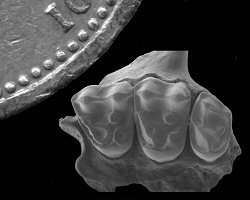Tiny primate fossils shed new light on our ancient ancestors

Palaeontologists are a step closer to understanding the origins of our primate ancestors following the discovery of the fossilised remains of two previously unknown primate species in Egypt. At 37 million years old the new species are some of the oldest human relatives ever found, as well as some of the smallest.
Picture: The tiny size of the fossilised upper teeth of Biretia megalopsis is apparent when compared to a £1 coin. Credit: Science/ E. Seiffert.
Fossil evidence demonstrates that higher primates or anthropoids, which include monkeys, apes and humans, have been evolving on the Afro-Arabian landmass for at least 45 million years. However, the evolution of early anthropoids in Afro-Arabia is poorly documented, with only a few isolated teeth found prior to 35 million years ago. A team of researchers from Oxford, the US and Egypt have shed new light on this period of evolution with the discovery of two new anthropoid species, Biretia fayumensis and Biretia megalopsis, which lived 37 million years ago.
The well-preserved pieces of teeth, jaw and facial bones were discovered at a site in the Fayum desert region in Northern Egypt. As well as being among the oldest known anthropoids the new species, described in the 14 October edition of Science, also appear to be among the smallest; Biretia fayumensis is estimated to have weighed between 160 and 270 grams – about the weight of a pack of butter – and is the smallest anthropoid found in the Fayum region.
A fossilised facial bone found by the team shows an unusually large eye socket, suggesting that one of the species, Biretia megalopsis, was nocturnal. This is a unique trait amongst early anthropoids and extremely unusual amongst living anthropoids – all of which are day-living with the exception of one South American species.
The dental features of both species link the Biretia primates both to the parapithecids – primitive anthropoids which first appeared around 35 million years ago – and the oldest undisputed Afro-Arabian anthropoid, the 45 million-year-old Algeripithecus. This evidence suggests the existence of a diverse group of parapithecid relatives extending back as early as 45 million years ago, and is likely to add fuel to the debate over whether anthropoids originated in Africa or Asia.
Dr Erik Seiffert, University Lecturer in Palaeobiology and Palaeoenvironments and Curator of Geological Collections at the Oxford University Museum of Natural History, is lead author of the paper. He said: ‘These fossils not only fill a major gap in our understanding of early anthropoid evolution, but also challenge prevailing views about the lifestyles of our Eocene relatives. With these discoveries we are much closer to understanding the time and place of origin of the living anthropoid primates, but we also see that the story of anthropoid origins is turning out to be far more complex than anybody imagined.’
Source: University of Oxford















